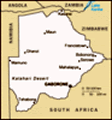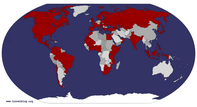Advertisement
Published: March 5th 2023
I had been to Botswana before, during my first ever backpacking trip when I was 21 and travelled from Nairobi down to Cape Town over three months. On that occasion, in 2001, I crossed over from Zambia and visited Chobe National Park before continuing into Zimbabwe. I remember that Botswana was quiet, relatively affluent, and full of wildlife. I discovered 22 years later that thankfully it hasn’t changed much.
Although, if I had visited Gaborone back then I might now be telling you that it had changed a lot. The country, and Gaborone especially, have been developing rapidly, which has driven a construction boom. Therefore, construction materials are needed, especially sand – the most mined mineral in the world. And where does the sand come from? Often from ephemeral river systems (they flow only once or twice a year in this semiarid region) and often illegally, causing depletion of water resources (no sand = nowhere for water to be stored), downstream flooding (intensive rainfall is no longer held back in the sands), destruction of vegetation and biodiversity loss, creation of pits that are an injury and drowning hazard to people and livestock, and making local people afraid to
visit their rivers for fear of attacks by illegal miners who commonly belong to criminal gangs.
When you reach the stage in research that you are designing your own projects and obtaining your own funding, in addition to targeting issues that you know are important, you can select locations that you really want to visit. We knew about the growing issue of sand mining in Southern Africa, knew it had been little researched, had a good mate that is now a lecturer at the University of Botswana who we could work with, and we liked the idea of spending some time in Botswana.
Maun The trip started in Maun, up in the Okavango Delta. This is perhaps the most famous feature of Botswana, the inland delta in an otherwise dry region that gradually floods months after rains fell hundreds of kilometres away in the highlands of Angola. It is beautiful and full of wildlife; the government and tourism industry are well aware of that thus charge you a fortune to visit. Low-density high-cost tourism is the avenue they’ve taken; resorts are luxurious, often you have to fly in. It’s enviable from
an ecosystem protection perspective but is off-putting to those who generally travel on a budget. There are two possible solutions, we opted for both: 1. travel during the off-season, and 2. stay in Maun and do trips into the delta from there. In fact, #1 was decided for us because the project commenced at the beginning of 2023 and we wanted to get some fieldwork done as soon as possible (also to escape the European winter). Even in Maun we got much cheaper rates, but didn’t anticipate just how quiet it would be. Over the almost five days we spent there, sometimes we were the only guests in the resort. We tried to get on a day safari up into Moremi National Park but were quoted over 500 Euros for the two of us. That price is for the vehicle and it holds about ten, therefore, we hoped to join others and divide the cost. Despite ringing around many companies and hanging on each day, we never managed to do a tour. However, we did manage a full day mokoro trip. It was a lovely drive of about an hour till we reached the furthest spit of water. There, we
each (three couples) clambered into our mokoro (previously a dug-out canoe, but nowadays in order to preserve the native trees, they are made from fibre-glass). Our driver/captain/poler/mokoro-handler/guide punted us across lakes, along narrow reed-lined passages, through expanses of lilies, it was delightful. We passed herds of grunting hippos, perched cormorants, kingfishers and eagles, an ambling family of giraffes, baboons surveying their lot from the top of termite mounds, then just as bums were getting numb, we stopped at an island. I like walking safaris, you can hear, smell and touch things rather than just looking at it from a noisy vehicle. Our mokoro poler now led us across the savannah to more forests and lakes where we saw elephants, zebra, wildebeest and families of ostrich (even the babies are massive!). it was boiling hot, but I could have kept walking all day. We did walk for two or three hours before eating our packed lunch and pleasantly mokoro-ing back again whence we came. When I asked the guide if there were predators like big cats here – expecting him to say no, hence we had no ranger with a gun that has accompanied my other walking safaris elsewhere in Africa
– and he told me “oh, yes, lions, leopards, wild dogs, hyena”. I guess even the predators are friendly in Botswana!
We expected the mokoro trip to be more about the mokoro experience itself; the wildlife we saw was wonderfully unexpected. Hence, we didn’t feel we were missing out by not finding a day safari into Moremi. Instead, our days fell into a lovely routine: we had the feast of a breakfast, then set off early for a walk around the lodge’s own grounds, usually walking for about 6-7 km over a couple of hours on sandy paths through the acacia, termite mounds and single baobab. There was only ever us out there in addition to the impala, kudu, monkeys, mongeese/mongooses and lots of beautiful birds, especially the kingfishers, hornbills, weavers and eagles. We would return to the lodge in mid-morning, have a drink, de-dust and chill in our own, albeit pretty chilly, swimming pool. Then we worked. Working from home is infinitely more pleasurable when sitting outside in 30C sunshine in the shade of big trees while looking out over a lovely meandering river. We also got some fieldwork and interviews done related to the project
when we discovered that illegal sand mining is a problem up here as well.
Gaborone This is where the work properly started. Thankfully our lecturer pal had arranged everything and we visited government offices, like the Land Board, as well as tribal chiefs and village councils. They took us to sand rivers near Gaborone that have been destroyed by mining. The practice was banned more than ten years ago so is now conducted illegally by criminal gangs overnight. We heard emotional stories of how they used to swim, fish and collect water from the river, there used to be big fruit trees and birds that fed on them, but all have now gone and the rivers are places of violence. Everyone we spoke to, even people in shops, taxi drivers, guesthouse owners, all were aware of the seriousness of the issue.
Over the weekend, despite the heat, we thought it would be a nice idea to climb Botswana’s highest mountain; it being not too far from Gaborone and we had a hire car for the fieldwork. Fortunately, we were upgraded for free to a 4wd rather than the tiny car we
booked – we really needed it for some of the dirt tracks we were led down to visit sand river mining sites. Otse Hill is only 1491 m high, and you start at around 1100 m, but for most of it there is no path. The pathless part begins just as the mountain gets very steep. It is basically a couple of hour scramble up through unnecessarily extremely spiky acacia bushes while clinging to rocks and branches. The view from the top was lovely, but it was quite an ordeal – I wouldn’t have wanted it to go on much longer. But it was Saturday and there is no parkrun in Botswana so we had to get our exercise fix somehow!
The next day before driving north to Palapye, we called in Gaborone Game Reserve. We had been warned by Botswana pals that it was a bit rubbish, especially as we had just been in Okavango Delta. However, confirming that the secret to happiness is low expectations, we loved it. We spent about three hours pootling around, stopping to watch impala, eland, kudu, warthogs, zebra, families of ostriches, big ugly maribou storks, and it’s right in town.
Don’t miss it if you are in Gaborone.
Palapye As well as the University of Botswana in Gaborone, another project partner is the Botswana International University of Science and Technology (BIUST) in Palapye. We spent nearly a week in that area and around Mahalapye, again visiting government people like the Department of Water Affairs and both licensed and illegal sand mining sites. Sand mining is licensed here in some areas because they are more remote so there are fewer affected people, and, after all, sand is required for most kinds of construction. However, we still saw vegetation destroyed by the mining sites, mining going beyond (both in area and depth) their permitted limits, and the sands contaminated with oil that will get into the groundwater that is utilised downstream by people and livestock. Other than the work (and a coal mine and power station), there’s not a lot going on in Palapye.
End After driving back to Gaborone we were up early the next morning for the bus to Johannesburg (three buses a day taking 6-7 hours but all three leave at 6-6:30 in the morning!?) then we
flew home to the Netherlands. I’ll be back in South Africa in March to work on the sand mining project again, as well as doing some teaching. However, just after the few weeks in Botswana we understood that the sand mining is a serious issue that few are tackling. We also realised that it’s a great country with lovely people and maybe if I come a third time I’ll finally get into the proper Okavango Delta (if someone will lend me a few thousand euros).
Advertisement
Tot: 0.611s; Tpl: 0.014s; cc: 31; qc: 149; dbt: 0.4141s; 1; m:domysql w:travelblog (10.17.0.13); sld: 1;
; mem: 1.6mb




























